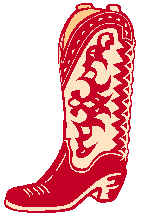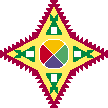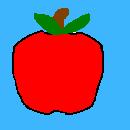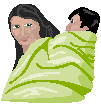ICE BREAKER GAMES
For workshops, school or just for fun, these
games can be played to "Break the Ice" in a group
Game One: Frozen
Name Game 
-
Everyone is instructed to walk slowly around the room.(MUST WALK)
-
One person is chosen to be "IT". (The Instructor at the beginning may wish
to play that part).
-
The person called IT, has to move amongst the people, all the while walking,
and touch them lightly, once touched those people are frozen. The people
walking around do not want to be touched, so they try to avoid the person
called IT.
-
Once frozen, the frozen person must stand with arms extended outwards.
Other unfrozen people can free them by walking under one of their arms
and learning three things about that person and yelling them out. I.e.
"I am freeing Wendy Kalkan, she likes to eat baked lasagna with lots of
cheese, and her favorite color is Blue".
-
After a while of playing, the game can get harder by having to list 5 things
about the person when you're unfreezing them and the person called "IT"
can also change.
-
When the person called "IT" touches someone they have to say that person's
name and then turn it around and say that person's name backwards
-
Developed by Lori Cockwill and Kelly Shaver, Four Worlds International
Institute.
Game Two: Storytelling,
Oral Histories

Oral histories are an important part of many cultures. Hearing the
stories over and over again help others to learn the story well enough
to pass it along to another generation.
-
The people in the class sit in a circle.
-
One person is selected to start.
-
Each person adds one word to create the story but must also say the entire
story that has already been said.
-
For example: Person 1-"The" Person 2-"The dog" Person 3-"The dog ran" Person
4-"The dog ran towards" and so on.
-
When someone forgets the correct wording in the story then it is over and
they get to start a new story.
Derived from the following:
Goodman, Joel & Weinstein, Matt, PlayFair: Everyone's Guide to Noncompetitive
Play. Impact Publishers, San Luis Obispo, CA, 1980. p. 142-143.
Game Three: The
39 Steps 
Instruct the class to find a partner whose thumb is relatively the
same size.
-
Everyone sits down, facing their partner.
-
Instruct the partners to gaze deep into each other's eyes and on the count
of "carrot", they both must call out a number between 0 and 15, Ready?...
-
Instructor: "Rootabaga...Spinach...Lettuce...Carrot!...
-
Each partner finds out what their partner yelled out and the two must add
their numbers together, the combined result should be between 0 and 30.
-
Everyone must get to their feet and stand back to back with their partner,
linking arms.
-
Instructor: "When I say Kangaroo, I'd like you to take exactly as many
jumps into the air, linked together, as the total of your two combined
scores".
Goodman, Joel & Weinstein, Matt, PlayFair: Everyone's Guide to Noncompetitive
Play. Impact Publishers, San Luis Obispo, CA. 1980. p. 108.
Game Four: Mind
- Stretchers

Props needed - 18 Mind Stretcher flashcards(click
here)
- Students will need paper and pen in their groups.
-
The Instructor presents the class with a series of mind teasers.
-
Instead of the students being isolated, they can join up in small groups.
Maximum 3 people.
-
Everyone gets 8-10 minutes to try and figure out all of the mind teasers
and write them down.
Goodman, Joel & Weinstein, Matt, PlayFair: Everyone's Guide to Noncompetitive
Play. Impact Publishers, San Luis Obispo, CA. 1980. p. 156-157.
Game Five: Clay
Dough

Everyone needs to get a piece of paper and a pencil.Everyone makes
a circle with one line running vertically through it and one line running
horizontally through it, i.e.
-
The Instructor tells the group that this symbol represents their own feelings'
wheel.
-
Each person writes four different feelings they have experienced that day
in each section.
-
Get the class to picture a coin flipping in their minds, and find a person
who got the same result as they did, i.e. paired groups are heads with
heads; and tails with tails.
-
When paired, the pair will decide who will be person A and who will be
person B.
-
For the first round all of the A's will be clay-dough, and all of the B's
will be the sculptors.
-
Person A must take one of the words from their feelings' wheel and whisper
it into the ear of person B. Person B must then try to mold person A into
the manner of the feeling they have just expressed to them.
-
Each group gets one minute to sculpt. Then the pair joins up with another
pair and they have a one-minute charades game, with the opposite set of
pairs trying to guess what person A is feeling. After this is complete,
the roles will change.
-
You can play until all 4 feelings from both partners have been molded and
sculpted.
Goodman, Joel & Weinstein, Matt, PlayFair: Everyone's Guide to Noncompetitive
Play. Impact Publishers, San Luis Obispo, CA. 1980. p. 134-135.
Game Six: Emotional
Relay Race
Props needed - A picture of an apple, a picture of pears and a picture
of bananas.(Must be equal number of people in each group).
-
Everyone finds some place for themselves where they can move around easily.
-
Everyone solely thinks up their own sound-and-movement that can be easily
expressed and repeated by them, that expresses the feeling of "Happiness".
They then do the same thing for "Sadness", and "Anger".
-
At the front of the room there will be 3 pictures, an apple, pears, and
bananas.
-



-
Everyone decides which one they'd like to eat and lines up behind it.
-
There is a relay race with three teams: apples, pears, and bananas. The
first person picks up their team picture and runs in a straight line to
the marker(a selected site at the back of the room).
-
At the marker, the participant puts down their symbol, then they do their
angry sound-and-movement, three times, and then run back to their starting
point. At the starting point, they do their happy sound-and-movement twice.
-
Then, they run back to the marker at the end of their lane and do their
sad sound-and-movement, three times. Then, pick up the team's symbol and
run back to the starting point and hand off to the next person. Each person
in the team does the same thing until everyone has one turn.
Goodman, Joel & Weinstein, Matt, PlayFair: Everyone's Guide to Noncompetitive
Play. Impact Publishers, San Luis Obispo, CA. 1980. p. 136-137.
Game Seven: Get
To Know One Another BINGO
 Click
the picture to see a sample card, you can change it to suit your community.
This was used in Nunavut, Canada.
Click
the picture to see a sample card, you can change it to suit your community.
This was used in Nunavut, Canada.
Props needed - A bingo card for each student and one for the instructor
- A pen or pencil for each student to mark off bingo squares
-
Each member gets a bingo card.
-
The Instructor reads off the master card randomly.
-
The participants mark each box that they qualify for, always thinking of
an example of the particular incident mentioned on the card.
-
The BLACK squares indicate things that are bad and in order to have a legitimate
BINGO, each participant is only allowed one black square in a Bingo line.
-
If someone yells BINGO, they have to read off all the squares and tell
something about each one.
-
There are no winners and no losers at this game of BINGO!
Developed Lori Cockwill and Kelly Shaver
Four Worlds International Institute.
Game Eight: Today's
Problems
Props needed - Instructor needs a blackboard, whiteboard or flip chart
paper and a writing instrument to write the following issues on.

Nuclear Warfare
Alcohol and Drug Abuse
Famine/Starvation
Family Violence
Pollution
Disease, AIDS and Cancer
Unemployment
Over Population
Terrorism
Racism
Crime
Moral Decline
Poverty
Mental Illness
Corruption Amongst Officials
Illiteracy
Oppression
Suicide
-
Allow the group to chose three of the most pressing issues facing their
community.
-
Allow them some time to think about these three issues and how they connect
to each other.
-
Allow the group some time to develop meaningful ways in which they could
develop solutions to some of these problems.
Bopp, Judie. Unity in Diversity: Curriculum Guide. Four Worlds International
Institute, Lethbridge. 1988. p. 34.
Game Nine: Dear
Friend

Props needed - Pen and paper for each group
-
Encourage the group to get in small groups of two or three and encourage
them to write letters to their future sons and daughters or grandchildren.
-
Encourage them to write about their own feelings and experiences and precautions.
-
Encourage them to want to provide some help for their future teenaged children.
-
For example, warning their future children about the harmful effects of
drugs, alcohol, etc.
Bopp, Judie. Unity in Diversity: Curriculum Guide. Four Worlds International
Institute, Lethbridge. 1988. p. 39.
Game Ten: Medicine
Wheels
Props needed - Instructor needs a blackboard, whiteboard or flip chart
paper and a writing instrument to write the brainstorming ideas on and
to draw medicine wheels on.
-
Encourage the class to brainstorm human needs, while the instructor writes
these down.
-
If they just focus on physical needs such as food and shelter then ask
them what needs separate them from animals until they can come up with
needs such as love and attention.
-
Once they come up with a large lists of needs give them the categories
of physical, emotional, mental, and spiritual needs, and put the ones they
brainstormed into these categories on the medicine wheel.
-
Discuss how these needs are interconnected and how they are all important
to being human. Discuss how the medicine wheel is about balance.
-
Next get the class to brainstorm other possible categories of four that
could be placed on a medicine wheel. For example
- Earth/ Air/ Water/ Fire
- Black/ White/ Red/ Yellow
- North/ South/ East/ West
Bopp, Judie. Unity in Diversity: Curriculum Guide. Four Worlds International
Institute, Lethbridge, 1988. p. 68-71.
Game Eleven: The
Clapping Game
-
Everyone sits in a circle on the floor crosslegged and picks a different
animal. Each person picks an animal and makes up a fast hand action and
sound to use for that animal.
-
Everyone begins by clapping both hands on their laps twice and then together
twice creating a rhythm.
-
One person is selected to start. On the two claps together they do their
animal symbol and sound instead. Then that person does two claps on their
lap and then another persons animal symbol and sound.
-
This sends the turn to that person. They then repeat this beginning with
their own symbol and sending it to another person.
-
When someone makes a mistake they have to start over.
Developed by Lori Cockwill and Kelly Shaver
Four Worlds International Institute.
Game Twelve: The
Topic Game
-
Everyone sits in a circle and someone is selected to start.
-
They choose a general topic, for example mammals.
-
Then you go around the circle and each person names a mammal such as a
horse, the next person may say dog, the next person says cat, etc.
-
Once someone can't think of a word that relates to the topic, the next
person gets to come up with a new topic.
-

Developed by Lori Cockwill and Kelly Shaver
Four Worlds International Institute.
Game Thirteen: Word
Association
-
Everyone sits in a circle and one person selects a word to begin.
-
The next person says a word that relates to the first word.
-
The next person says a word that relates to the last word.
-
In one round no word can be used twice.
-
E.g. Cars-Tires-Rubber-Tree-Bird-Feather

Developed by Lori Cockwill and Kelly Shaver
Four Worlds International Institute.
Click
the picture to see a sample card, you can change it to suit your community.
This was used in Nunavut, Canada.